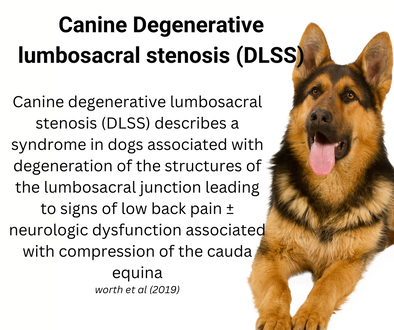|
DLSS is a condition that affects the spinal canal, leading to the narrowing of the space and compression of the spinal cord and nerves. Dogs can suffer from this debilitating condition, which can cause pain, weakness, and a decline in their quality of life. In this blog post, we will delve into the causes, symptoms, and treatment options for spinal stenosis in dogs, shedding light on the importance of early detection and specialised care. Understanding Spinal Stenosis: Canine degenerative lumbosacral stenosis (DLSS) describes a syndrome in dogs associated with degeneration of the structures of the lumbosacral junction leading to signs of low back pain ± neurologic dysfunction associated with compression of the cauda equina. DLSS has a multifactorial origin in which intervertebral disc (IVD) degeneration plays a major role. However, the DLSS syndrome lacks pathognomonic characteristics, and diagnosis is often presumptive based on a combination of clinical signs, findings on advanced imaging, and ruling out other specific etiologies that cause cauda equina compression (Worth et al 2019) Incidence and prevalence of spinal stenosis in dogs: While exact figures for the incidence and prevalence of spinal stenosis in dogs are challenging to determine, research suggests that certain breeds are more susceptible. In general breeds like German Shepherds, and Doberman Pinschers are at a higher risk due to their anatomical conformation and genetic factors Recognising the symptoms:
.Detecting spinal stenosis in its early stages is crucial for successful management. Dogs with spinal stenosis may exhibit symptoms such as back pain, difficulty with certain movements, loss of coordination, hind limb weakness, and, in severe cases, paralysis. Prompt recognition of these signs can help initiate appropriate treatment and improve outcomes. Diagnostic Techniques: Accurate diagnosis is key to developing an effective treatment plan. Veterinary professionals may employ diagnostic imaging techniques such as radiography, computed tomography (CT), or magnetic resonance imaging (MRI) to evaluate the extent of stenosis, identify underlying causes, and assess the impact on the spinal cord and nerves Treatment Approaches: The treatment of spinal stenosis in dogs aims to alleviate pain, improve mobility, and enhance the overall quality of life. The specific treatment approach depends on the type and severity of stenosis. Treatment options may include: a. Medication: Pain management medication, such as non-steroidal anti-inflammatory drugs (NSAIDs) or analgesics, may be prescribed to reduce inflammation and alleviate discomfort. b. Physiotherapy and Rehabilitation: Canine rehabilitation therapists play a vital role in managing spinal stenosis. Through tailored treatment plans, they focus on pain management, range of motion exercises, hydrotherapy, and strengthening activities to enhance the dog's mobility and promote healing. c. Surgery: In more severe cases of spinal stenosis, surgical intervention may be necessary. Surgical options include decompression, distraction stabilisation technique or laminectomy, which involves removing the bone or tissue that is compressing the spinal cord, or spinal fusion to stabilise the affected area. Home care and long term management: Continued care at home is essential for the long-term management of spinal stenosis. Canine physiotherapists educate owners on exercises, environmental modifications, and assistive devices that can support the dog's mobility and comfort. Compliance with prescribed home care is crucial for maximising the benefits of rehabilitation therapy Spinal stenosis in dogs can significantly impact their mobility, comfort, and overall quality of life. Canine physiotherapists play a vital role in managing this condition, offering non-surgical alternative Spinal stenosis can significantly impact a dog's mobility and overall well-being. Early detection, accurate diagnosis, and a comprehensive treatment approach are key to managing this condition effectively. By working closely with veterinary professionals and canine physiotherapists, owners can provide their dogs with the specialised care needed to alleviate pain, improve mobility, and enhance their quality of life. References: Worth et al (2019) Canine Degenerative Lumbosacral Stenosis: Prevalence, Impact And Management Strategies |
AuthorJoanna Whitehead Archives
June 2024
Categories
All
|


 RSS Feed
RSS Feed
